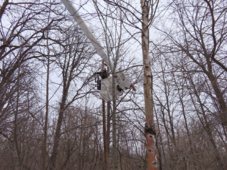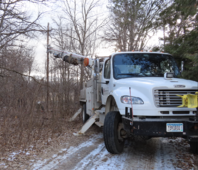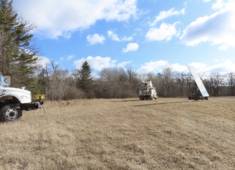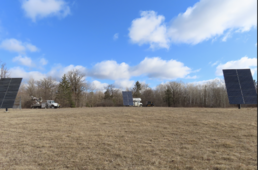Have both an EG4 18kPV and a pair of Victron Quattro 5kVAs. There is a 200A manual transfer switch that will eventually allow to switch between the two to the main service panel. And if something really bad happens have an Outback FX3648 that is not connected but could be if something really goes bad. Thinking weakest link would be battery storage. Currently have over 70kWh. Reminded me to get more spare T fuses and a spare BMS. As really last resort for that have a smallish solar generator that could still power well pump at least.Remember to have backups for your backups.
You are using an out of date browser. It may not display this or other websites correctly.
You should upgrade or use an alternative browser.
You should upgrade or use an alternative browser.
Permanently removing utility power
- Thread starter rhino
- Start date
Nobodybusiness
Collecting the leftovers of the Great Sky Reactor.
Yea me too.That is a pretty short trial run for such a drastic change.
I have been off grid (never was connected) for 6 years now. No propane or firewood and 5-15 gallons of fuel for generators annually. It isn't easy. I would probably need to throw another $20k at my system to be relaxed with my power consumption. Perhaps you are already there with yours.
It’s December January that are the issue.
All other months seem fine or at least manageable
KnobCountry
Leg puller. Zap avoider.
This is awesome and must feel great. Nice job!
It is disconnected! Transformer removed and all wiring and meter after transformer removed. It actually noticeably gives a completely different feel outside now not having the line go across the backyard. You obviously get used to the look of the line being there but when it is removed it really feels and looks different. Feels much more open and can see the sky uninterrupted now.
They still have to pull the line from the transformer to the road (probably about 1/4 mile) but need to have the fiber optic line located near the road first since they have to put a new anchor in to brace the pole after the loss of my line.
He also mentioned they will pull the utility poles straight out of the ground with their larger truck they have even with the ground frozen. I asked him what they did with the pole and he said "give them away". I said I did not want them. People should review this before thinking that is a good deal.
He thought the transformer was from the 1940's and the utility pole itself looks like from the 1940s. For the transformer they have to have the oil inside it tested and if it tests over 50ppm of PCBs it has to be handled by hazardous waste company, if not it gets sent to another company for refurbishment.
Another thing he mentioned is they are getting a lot of solar installs net metering and they are having to pay more for the solar power then they can resell it back to customers. So they are losing money on all of them. I'm not sure how that is sustainable.
Continuing to chat with him, there was a "big farmer" with an installation that is at the end of a line trying to sell back to the grid and having a lot of issues because the infrastructure at the end of these lines tends to be a lot older and in this case it isn't stabilizing with the grid properly. He says the older "regulators" only worked one way and to replace the regulator would be $50k. They have an engineer working on the problem since it sounds like they are trying to avoid having to spend $50k for one customer.

They still have to pull the line from the transformer to the road (probably about 1/4 mile) but need to have the fiber optic line located near the road first since they have to put a new anchor in to brace the pole after the loss of my line.
He also mentioned they will pull the utility poles straight out of the ground with their larger truck they have even with the ground frozen. I asked him what they did with the pole and he said "give them away". I said I did not want them. People should review this before thinking that is a good deal.
He thought the transformer was from the 1940's and the utility pole itself looks like from the 1940s. For the transformer they have to have the oil inside it tested and if it tests over 50ppm of PCBs it has to be handled by hazardous waste company, if not it gets sent to another company for refurbishment.
Another thing he mentioned is they are getting a lot of solar installs net metering and they are having to pay more for the solar power then they can resell it back to customers. So they are losing money on all of them. I'm not sure how that is sustainable.
Continuing to chat with him, there was a "big farmer" with an installation that is at the end of a line trying to sell back to the grid and having a lot of issues because the infrastructure at the end of these lines tends to be a lot older and in this case it isn't stabilizing with the grid properly. He says the older "regulators" only worked one way and to replace the regulator would be $50k. They have an engineer working on the problem since it sounds like they are trying to avoid having to spend $50k for one customer.

Yes, still have fiber optics so I can talk to you guysSo you still have land line/telco needs?
seneysolar
Solar Enthusiast
Thats an interesting read on the utility poles, thanks for posting
Interesting problem. Older "tap changer" regulators would change the conversion ratio of the transformer if voltage dropped past a certain point, so you'd get another 5% voltage. But obviously that doesn't help when the voltage rises.He says the older "regulators" only worked one way and to replace the regulator would be $50k. They have an engineer working on the problem since it sounds like they are trying to avoid having to spend $50k for one customer.
That farmer might benefit from equipment that is simply OK with a wider operating voltage range. Or better controls so he never exports more than X kilowatts.
wattmatters
Solar Wizard
It's a shame your utility/local regulatory system is so backward because remaining on the grid here is far more environmentally beneficial than cutting the cord.
Both in terms of being able to consume excess renewables at times (demand management, e.g. for heating water) and the ability to supply renewable energy back to the wider grid, offsetting fossil generation. Rooftop PV alone here supplies 11% of national grid demand and has directly offset coal and gas generation, which while falling rapidly, still supplies 61% of total grid demand.
Both in terms of being able to consume excess renewables at times (demand management, e.g. for heating water) and the ability to supply renewable energy back to the wider grid, offsetting fossil generation. Rooftop PV alone here supplies 11% of national grid demand and has directly offset coal and gas generation, which while falling rapidly, still supplies 61% of total grid demand.
So without the poles is it all underground?Yes, still have fiber optics so I can talk to you guys
I’m guessing the issue is needing bidirectional regulators.Interesting problem. Older "tap changer" regulators would change the conversion ratio of the transformer if voltage dropped past a certain point, so you'd get another 5% voltage. But obviously that doesn't help when the voltage rises.
That farmer might benefit from equipment that is simply OK with a wider operating voltage range. Or better controls so he never exports more than X kilowatts.
So when the flow is back to the source (opposite of normal flow to the load), the regs don’t stay locked when the load side voltage starts to rise and high voltage becomes an issue.
The same issue can happen at the substation, many power transformers need an LTC wired for reverse power with an LTC control box to match.
Regulators are not cheap (with stupid long lead times) sadly the project who causes the needed upgrades (the Pv site) have been asked to flip the bill.
Yes, that is what the issue is. They are only one way regulators but they really need bidirectional and he said they cost $50k so that is why an engineer is trying to figure out work around I guess.I’m guessing the issue is needing bidirectional regulators.
Only thing on poles around here is power. The telephone/internet company is a co-op not investor owned so they actually properly buried all the fiber optics in the entire service area. I believe the service area is over 1000 square miles.So without the poles is it all underground?
The local electric is a co-op also but they definitely don't know what they are doing.
ksmithaz1
Solar / EV Junkie
Much cheaper to bury fiber vs power.
Also there were tons and tons of federal money for spreading internet to rural areas and fiber was the go to solution once “free” money was involved.
Fiber is just better than copper period. People always think of the cost of the fiber components being more, but the real cost is in everything else. digging, right-of-way, permitting, hassle. I have NEVER understood why underground power isn't run with multi-strand fiber in the bundle. "They" should have de-coupled energy generation from the transmission ages ago. IMNSHO, communication and power and all that should be brought to each home, tied back to a central distribution point. This infrastructure should be contracted and controlled by local governmental orgs. Then let the power companies and communications outfits tie in and sell service from the distribution point. Oh well, opinons are like *ssholes.
Me too! and he is in Minnesota, which I assume based on Latitude alone, gets less sun hours per everything (month, year, day) than Ohio or Missouri.Pray for regular clear skies.
I'd be sweating bullets if I was totally reliant on solar and the weather report called for clouds for a week, which happens quite regularly here in winter.
I installed additional 14kW this past Fall and even in cloudy skies that often provides enough for the base load.Pray for regular clear skies.
They really didn't say anything.. didn't even wave or look at me when they left even though I was standing out there where they were workingWhat did poco employees say about your offgrid solar and about you removing service?
Just think there is a lot of fear and hoping my example inspires more.Me too! and he is in Minnesota, which I assume based on Latitude alone, gets less sun hours per everything (month, year, day) than Ohio or Missouri.
No Starlink available?Yes, still have fiber optics so I can talk to you guys
Similar threads
- Replies
- 96
- Views
- 4K
- Replies
- 2
- Views
- 168







